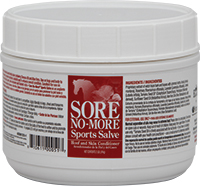
Don't Be Scared of Scars
No matter how they are created, all wounds go through the same healing process and there are very specific stages through which the wound should progress in order to minimize scarring or hair loss.
The body’s initial reaction to the wound is to restrict blood flow to the area in an effort to prevent hemorrhaging. The blood contains a fibrous protein that activates to form the clotting factor. The surrounding blood vessels will produce inflammatory cells, called macrophages and neutrophils, that help in the cleanup process. This phase typically lasts six hours, unless complications, such as infection, interfere.
The excess amount of blood to the area is what causes the heat, swelling, redness and pain in the area. We try to keep this in check with anti-inflammatory medications and cold hosing, since too much inflammation can impede the next phase of healing. It is important when hosing, to use low pressure so as not to disturb any fragile healing at that stage. It is also possible to drive contaminants into the wound if it is not sealed over well enough.It is important to consult your veterinarian if you think the wound needs to be sutured or debrided to remove any contaminants or causes of additional inflammation.
Next, the wound will enter the granulation phase where the fibroblasts and myofibroblasts help pull the edges of the wound together so that it can begin to close up. Depending on the wound, sutures may be necessary help close the gap so the wound can come together to heal properly. This process can take weeks to fully complete and, even if the wound appears to be healed, there may be more healing occurring under the surface.
Residual signs of the wound may show by causing changes to hair color and scarring. The cells in the hair follicles undergo damage during the initial injury and healing process which can create changes in pigmentation. Additionally, scar tissue does not have the same strength and elasticity as the original and lacks the fiber patterns in normal collagen. Because of this, restriction of movement may be recommended as, if a wound hasn't reached a certain degree of healing, it may be re-opened easily.
Scars are affected not only by the size of the wound and duration of healing time, but by the location on the body. The areas of the body that contain good blood supply, body fat and muscle structure are more likely to provide adequate flexibility for closing and healing of the tissue. Lower limbs of a horse lack in fat and large muscle groups so the skin may be more taut and less flexible, leading to a higher likelihood of scarring.
It is difficult to predict the extent of scarring of a wound since there are many factors that need to be monitored.
CLEANING: It is important to keep the wound clean and moist with simple hosing or, if your vet recommends it, a saline solution.
BANDAGING: If keeping the wound covered is an option, this can prove very helpful in keeping it clean. However, there are some areas of the body or specific types of wounds that are often recommended to leave unbandaged. Consulting with your veterinarian is the best way to determine the best management plan for your horse.
TOPICALS: Some areas are difficult to bandage and, for those, it can be helpful to apply a topical dressing designed to heal and reduce scarring. Some topicals may encourage the growth of new cells while others may disrupt the body’s natural process or attract bugs, bedding and debris. Working with your vet to ensure the right topical dressing for your horse's specific injury is important.
Scarring may be unsightly but it does not mean it will impede movement or performance. Once the wound is healed, it is then safe to use petroleum based products which may be a caution during the granulation phase of the wound.
ARENUS TIP:
While there are many topical products available that claim to help with scar reduction and hair regrowth, the best kept secret is the Polynesian nut oil of the Tamanu seed (Colophyllum tacamchaca). This oil is revered for its amazing abilities to help many skin conditions, including scarring. In fact, the nut itself is known for its anti-bacterial, anti-oxidant and anti-inflammatory properties.
Sore No-More Sport Salve has combined the benefits of the classic Sore No-More Liniment with the healing and soothing effects of Tamanu oil. Sports Salve is most helpful when hair regrowth is desired around a wound area or blanket rub and it is effective in rehydrating dry skin and hooves or other disturbed areas.



